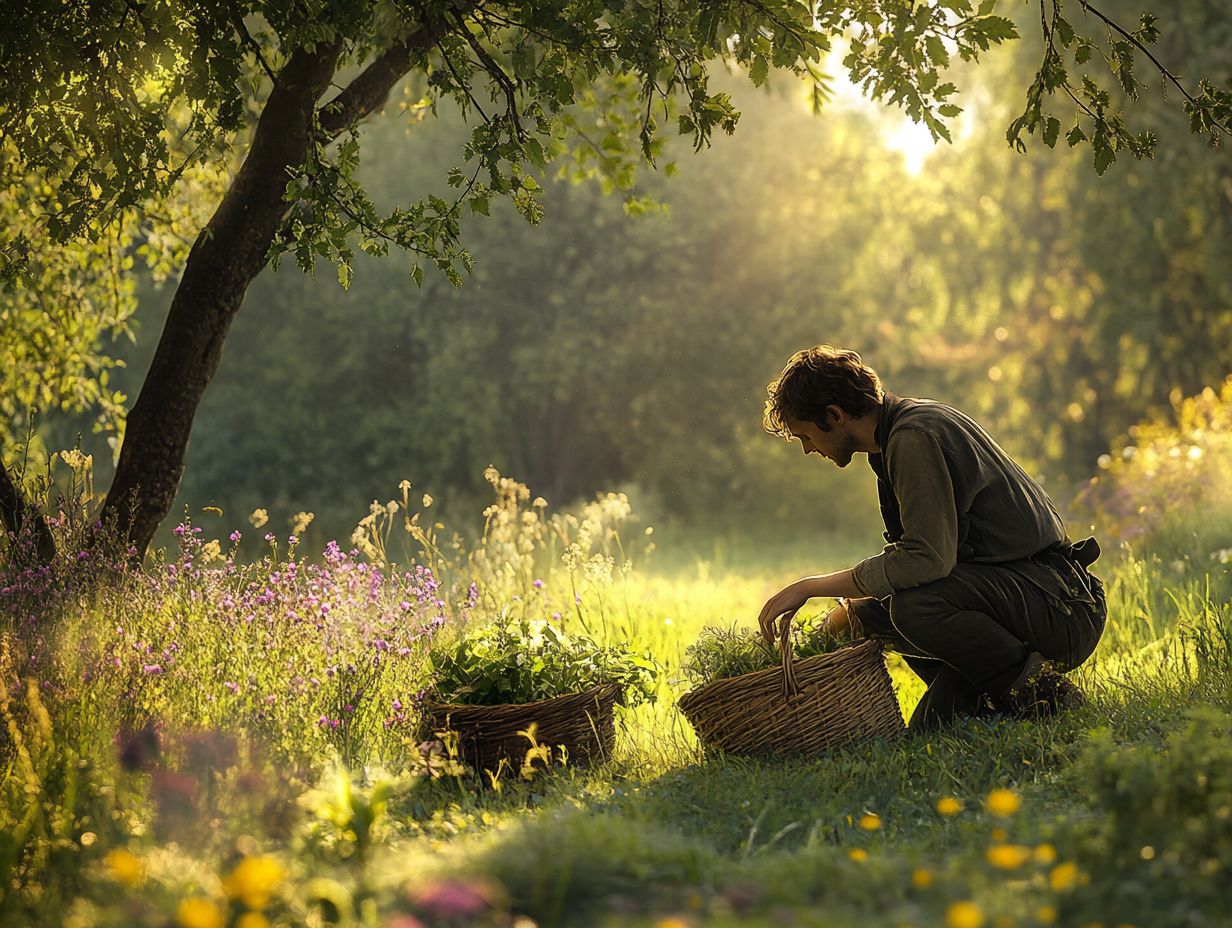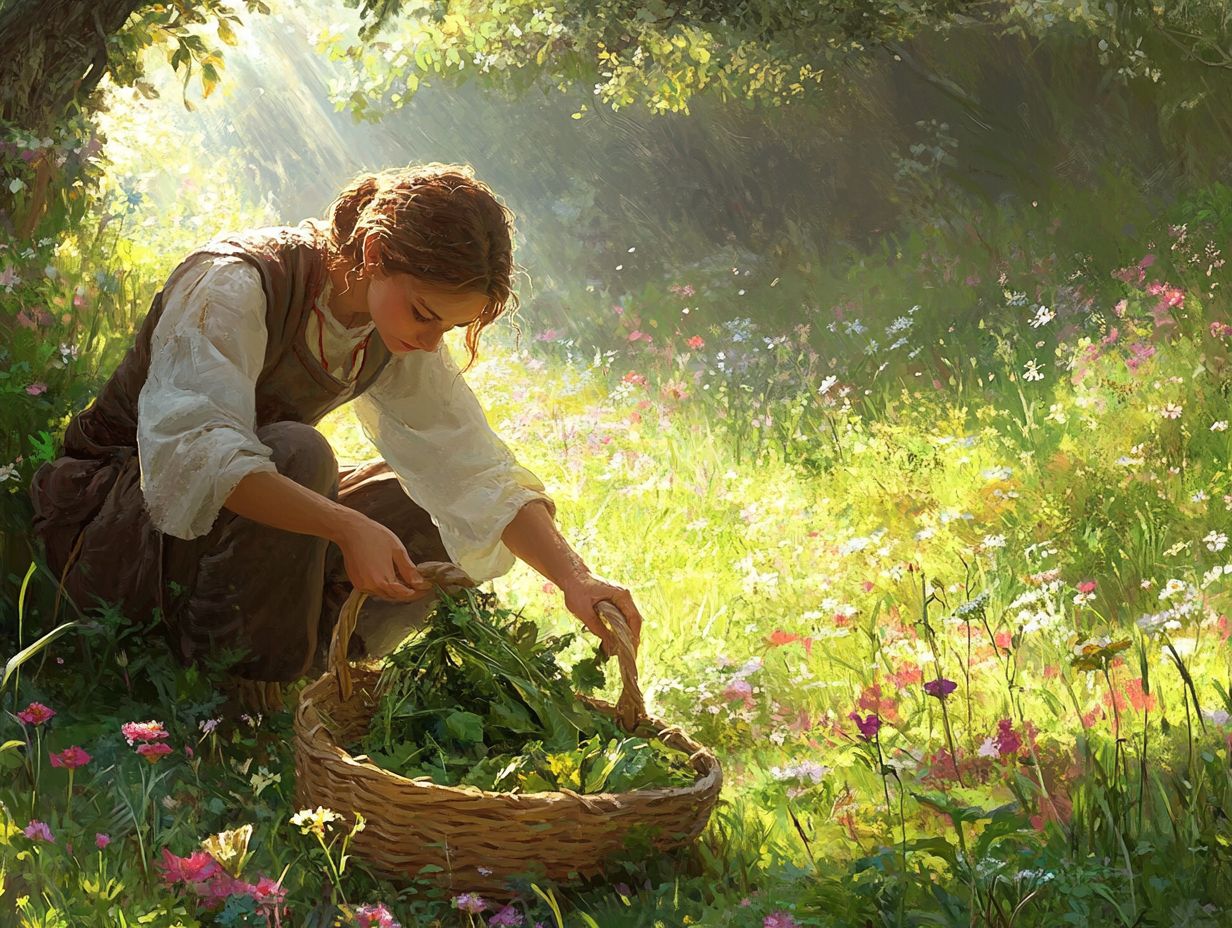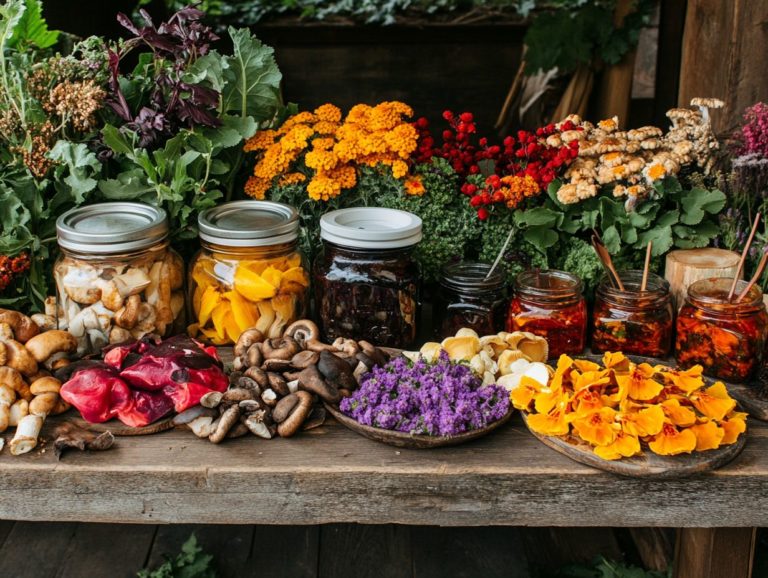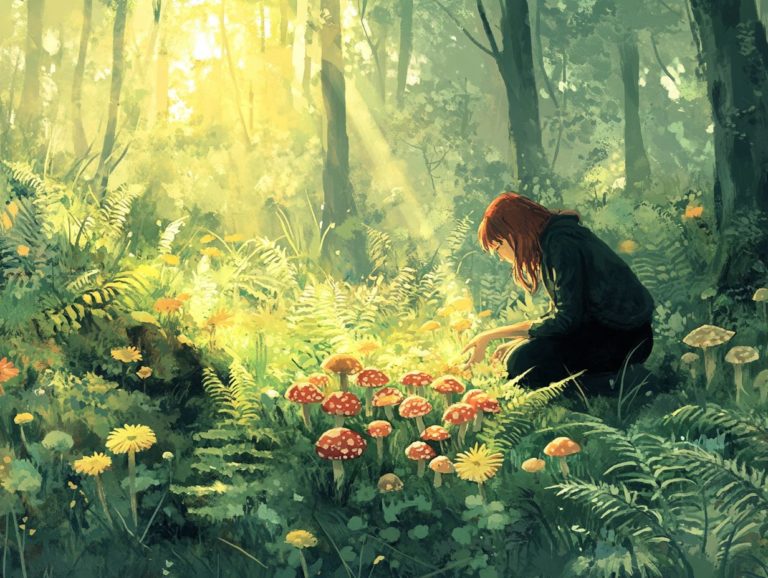Spring Foraging for Beginners: What to Know
Spring foraging is a thrilling adventure! You ll uncover a world of tasty plants just waiting to be discovered.
As the earth awakens from its winter slumber, vibrant greens emerge. They offer delectable flavors and a host of nutritional and environmental benefits.
This guide will equip you with the essentials of spring foraging, from identifying the right plants to gathering your tools and ensuring your safety as you embark on this enriching outdoor journey.
Whether you’re a seasoned forager or simply curious to dip your toes into this world, there s something here for everyone to explore and enjoy.
Contents
Key Takeaways:

What is Spring Foraging?
Spring foraging invites you to master the art of gathering wild, nutrient-rich edible plants during the lively season of spring. This experience allows you to reconnect with nature while discovering a remarkable variety of wild foods. It’s not just an adventure; it’s a step toward a more sustainable lifestyle that cultivates an appreciation for the variety of plants and animals surrounding you. For those looking to continue foraging into the warmer months, check out summer foraging essentials for tips and tricks.
As you engage with the environment through foraging, you ll enhance your cooking skills with organic ingredients and delicious flavors. You ll even explore the intriguing world of wildcrafting, making this journey profoundly enriching for both body and spirit.
Historically, foraging has been a vital survival skill, rooted in ancient cultures that depended on the natural bounty of their environments for sustenance.
As the seasons change, particularly in spring, the landscape comes alive with fresh growth delicate young greens, vibrant blossoms, and roots just waiting to be discovered. Edible plants like dandelion, ramps, and wild garlic not only nourish you but also provide flavors often missing from their cultivated counterparts.
This deep connection to the earth helps you understand seasonal cycles better. It encourages you to embrace mindful consumption of wild foods, a practice that beautifully aligns with the principles of sustainability.
Benefits of Spring Foraging
Spring foraging offers incredible benefits! Dive into a world of nutrition and environmental health.
Nutritional and Environmental Benefits
Foraging for wild greens in the spring offers you immense nutritional benefits. Many of these edible plants are classified as superfoods, brimming with vitamins and minerals essential for a healthy diet, all while championing sustainable environmental practices.
Take dandelion greens, for instance. They shine with high levels of vitamins A, C, and K, along with a wealth of antioxidants that can give your immune system a robust boost. Then there’s chickweed, a delicate powerhouse that packs in vitamins and omega-3 fatty acids, both of which are fantastic for promoting heart health.
Don’t overlook stinging nettle; this often-misunderstood plant is loaded with iron, calcium, and protein, making it a stellar addition to your nutritional regimen. Beyond their impressive dietary qualities, these wild greens play a vital role in supporting variety of plants and animals and ecosystem balance. They attract beneficial insects and create habitats where various organisms can flourish, ultimately contributing to a healthier environment for all.
Basic Guidelines for Spring Foraging

Spring is here, and it’s the perfect time to dive into foraging! When embarking on your spring foraging journey, it’s essential to follow fundamental guidelines that cover several critical aspects. Start with the proper identification of edible plants—this is the cornerstone of a successful experience. For more insights, check out The Art of Seasonal Foraging: A Beginner’s Guide.
Equip yourself with the necessary tools and gear to ensure you’re well-prepared for your adventure. Always prioritize sustainable practices, which help preserve nature while you forage. This allows you to fully savor the richness of the outdoors while ensuring it thrives for future foragers.
Identifying Edible Plants
Identifying edible plants and medicinal plants is an essential skill for foragers. It allows you to confidently differentiate between safe, nutritious options like wild garlic and clover, and potentially harmful varieties.
To explore foraging successfully, leverage a range of resources, including comprehensive guidebooks books that provide detailed information about plants and mobile apps that spotlight local flora. It s crucial to observe specific characteristics such as leaf shape, flower color, and growth patterns.
Take ramps, for example; often found in woodlands, they re easily recognized by their broad, green leaves and robust garlic aroma. In contrast, miner s lettuce, with its round leaves forming a rosette, flourishes in moist, shady areas.
Proper identification enriches your foraging experience and minimizes the risks tied to consuming toxic plants. By familiarizing yourself with these safe-to-eat options, you can enjoy nourishing meals while ensuring your safety along the way.
Tools and Equipment Needed
The right tools and equipment can elevate your spring foraging experience, making it both efficient and enjoyable. Essential items include a sharp knife for harvesting, a sturdy basket for collection, and a reliable field guide for plant identification. These tools not only enhance your adventure but also prioritize safety and efficiency.
As a beginner, consider starting with a sturdy basket or a cloth bag to collect your foraged treasures. A simple yet effective foraging knife is great for precise cutting without unnecessary risk. If you’re a seasoned forager, you might find specialized gear particularly beneficial think gloves for managing prickly plants and a more robust knife for tackling tougher roots.
A dependable field guide is invaluable for everyone, offering essential insights into safe harvesting practices and aiding in distinguishing similar-looking species in the wild.
Common Plants to Forage in Spring
In spring, you’ll discover a treasure trove of common plants ripe for foraging! Among these, you’ll find nutrient-dense delights like dandelion, miner’s lettuce, and wild garlic, as well as the exquisite flavors of morel mushrooms and fiddlehead ferns. To enhance your foraging adventures, check out wild edible plants: a beginner’s guide, each offering a unique culinary experience.
Identifying and Preparing Wild Edibles

Identifying and preparing wild edibles like wild garlic and stinging nettle is essential for anyone interested in foraging. This allows you to transform freshly gathered ingredients into delectable recipes that celebrate the flavors of spring!
By carefully exploring local flora, you can uncover a bounty of nutrient-rich plants like dandelions, ramps, and nettles. The first step is to educate yourself on safe identification techniques, using field guides or smartphone apps for verification. Once you become familiar with these ingredients, the next phase involves harvesting them responsibly, ensuring sustainable growth for future seasons.
After gathering, the preparation methods can vary widely think saut ing, steaming, or crafting flavorful pestos and soups. For an adventurous twist, consider infusing wild herbs into oils or vinegars, expanding your culinary horizons and enriching your everyday meals with nature’s vibrant offerings.
Grab your basket, gather your tools, and let the adventure begin!
Safety Precautions for Spring Foraging
When it comes to spring foraging, prioritizing safety precautions is essential. Understanding the potential risks associated with wild plants, as outlined in the basics of foraging: identifying edibles, can help you avoid health issues and ensure a safe and enjoyable foraging experience.
Be prepared, and you’ll turn your foraging trips into exciting adventures filled with amazing finds!
Potential Risks and How to Avoid Them
The potential risks of foraging include encountering plants that can make you sick if eaten, such as poison ivy and hemlock. You could also experience allergic reactions or misidentify species, making it crucial to equip yourself with the knowledge needed to navigate these challenges successfully.
Knowing common toxic plants can help you avoid serious health issues. Stay alert! Identifying symptoms of plant-related allergies early can prevent serious health risks. Symptoms may show up as rashes, respiratory irritation, or gastrointestinal distress.
Investing time in thorough research whether through reputable foraging guides, credible online resources, or hands-on workshops can significantly reduce the risk of unintentional encounters with harmful species. It s wise to cross-reference multiple sources to confirm your identifications, ensuring a safer and more enjoyable foraging adventure.
Educating yourself not only enhances your experience but also deepens your appreciation for the natural world around you.
Frequently Asked Questions
What is spring foraging?

Spring foraging is the practice of gathering wild edible plants, herbs, and mushrooms during the spring season. It’s a wonderful way to connect with nature and learn about different plant species. For those new to this activity, understanding what beginners should know about foraging can help you incorporate fresh, nutrient-dense ingredients like wild garlic and stinging nettle into your diet.
Why is spring a good time for foraging?
Spring is the perfect time for foraging because many plants are in their prime growing season. The fresh, new growth provides a variety of edible options, and the cool, mild weather makes for comfortable outdoor excursions. To get started, check out the top 5 foraging techniques for beginners.
What are some common plants to forage for in the spring?
Some common plants to forage for in the spring include dandelions, ramps, fiddlehead ferns, wild violets, chickweed, miner’s lettuce, and morel mushrooms. Always be sure to properly identify plants before consuming them, and refer to the dos and don’ts of foraging to ensure you only forage in areas where it is legal and safe to do so.
How do I know if a plant is safe to eat?
Proper identification is key when foraging for wild plants. Do your research and consult with an experienced forager or use a reliable field guide before consuming any wild plants. Avoid plants with look-alike poisonous counterparts and always start by trying a small amount to ensure you do not have any adverse reactions.
Are there any precautions I should take when spring foraging?
Yes, there are a few precautions to keep in mind when foraging in the spring. Always wear appropriate clothing and footwear, bring a map and compass, and inform someone of your plans. It’s also important to respect the environment and only forage in areas where you have permission and it is safe to do so. For those interested in what to look for, consider exploring spring wildflowers: edibles you can forage.
How can I incorporate foraged ingredients into my cooking?
There are endless ways to use foraged ingredients in your cooking. You can add them to salads, stir-fries, soups, teas, and more. You can also preserve them by drying, pickling, or freezing for later use. Just be sure to clean and prepare the ingredients properly before cooking with them.






